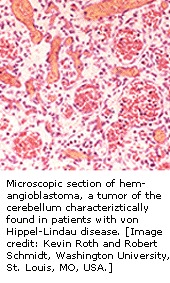
Von Hippel-Lindau syndrome is an inherited multi-system disorder characterized by abnormal growth of blood vessels. While blood vessels normally grow like trees, in people with VHL little knots of blood capillaries sometimes occur. These knots are called angiomas or hemangioblastomas. Growths may develop in the retina, certain areas of the brain, the spinal cord, the adrenal glands and other parts of the body.
The gene for Von-Hippel Lindau disease (VHL) is found on chromosome 3, and is inherited in a dominant fashion. If one parent has a dominant gene, each child has a 50-50 chance of inheriting that gene. The VHL gene is a tumor suppressor gene. This means that its role in a normal cell is to stop uncontrolled growth and proliferation. If the gene is lost or mutated, then its inhibitory affect on cell growth is lost or diminished, which, in combination with defects in other regulatory proteins, can lead to cancerous growth. LIke the Rb tumor suppressor gene, VHL seems to act as a 'gatekeeper' to the multistep process of tumorigenesis.
Although unrelated to any other known family of human proteins, homologs to human VHL are found in mice and rats. Experiments using these animals as model organisms for the human disease are helping researchers discover the normal physiological role of VHL, which will shed light on its mechanism of pathogenesis. Initial results suggest that VHL may play a role in regulating exit form the cell cycle.
Publication Details
Copyright
Publisher
National Center for Biotechnology Information (US), Bethesda (MD)
NLM Citation
National Center for Biotechnology Information (US). Genes and Disease [Internet]. Bethesda (MD): National Center for Biotechnology Information (US); 1998-. Von Hippel-Lindau syndrome.